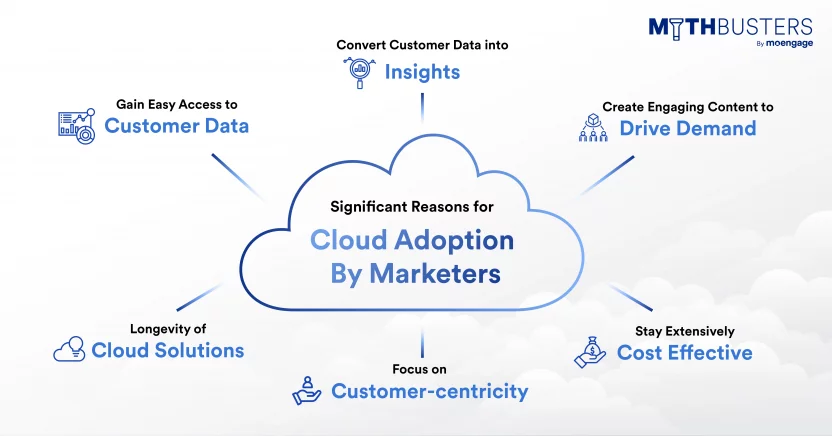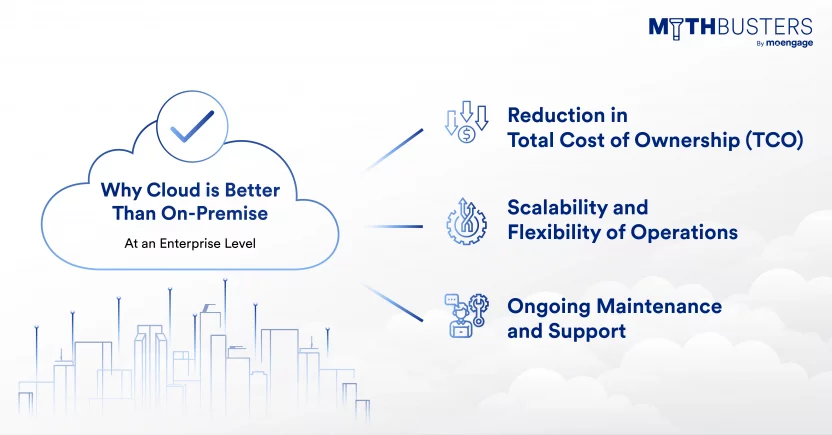On-Premise vs. Cloud: What Should Brands Pick for Customer Engagement?

Reading Time: 7 minutes
| Mythbusters by MoEngage is a series that answers the most common questions and misconceptions in the world of Customer Engagement. With this series, we aim to help you guide your teams to the right practices and put your customers above everything else. This edition of the Mythbuster series sheds light on how cloud adoption can help marketers further engage with their customers. |
Over the last couple of years, many consumer brands and enterprises have been wrestling with the question, “Should we continue to invest in on-premise infrastructure or switch to cloud computing services for driving customer engagement?” While modern brands have shifted to public cloud infrastructure, many enterprises are yet to take the leap for various reasons.
It’s no surprise that the public cloud infrastructure has witnessed significant growth, as it promises to offer newfound flexibility for enterprises, everything from saving time to the quicker accessibility of data. In fact, according to a study, 87% of global IT decision-makers acknowledged the acceleration in cloud migration.

Even Gartner stated that the cloud infrastructure would be the centerpiece of the digital experience. With benefits aplenty, cloud technologies have caught the keen attention of marketers.
John Dillon, CEO of Engine Yard, a cloud-based platform-as-a-service company, says, “The cloud is agile, elastic, and iterative—an excellent foundation for building customer engagement solutions. The cloud resources offer new ways to slash the time and expense of developing new ideas that take customer engagement to new heights.”
Significant Reasons for Cloud Adoption By Marketers
Meaningful customer engagement remains a North Star metric for all consumer brands. And cloud infrastructure remains a crucial element in achieving that north star. Below are the benefits:

Gain Easy Access to Customer Data
- Cloud computing helps you collect and analyze customer data instantly. In turn, access to this information allows you to create personalized customer-centric campaigns. You can also examine changes in market trends and adapt your strategies to accommodate them.
Convert Customer Data into Insights
- Besides storing valuable customer data, cloud computing, through its powerful analytics tools, allows marketers to convert that data into insights. You can leverage cloud-based analytics tools to generate insights and create a more customized experience. Further, you can use these tools to test new marketing channels, determine strategies, and understand customers more accurately.
Create Engaging Content to Drive Demand
- Quality content is key to customer engagement. You can identify the best-performing content and theme using cloud-based data analytics tools. This can help you resonate with your customers through engagement campaigns.
Stay Extensively Cost-effective
- Cloud computing remains a cost-effective method. You need not spend capital on in-house hardware and software solutions to store essential information. Instead, with the cloud infrastructure, you can automate processes, saving time and money.
Focus on Customer-centricity
- Using cloud-based applications allows you to create end-business products that are customer-friendly with a quicker turnaround time. This gives your marketing team a chance to develop personalized campaigns to engage and retain customers.
Longevity of Cloud Solutions
- The customer engagement space is ever-evolving. Custom-built solutions implemented today might not be as relevant three years later. Cloud solutions are ever-evolving with futuristic product roadmaps. They can proactively deliver innovative industry-first features by watching out for key trends and requirements in the domain.
These advantages are a testament to the significance of cloud adoption. A clearer picture can be painted if you look at the overall advantages of cloud over on-premise.
Why Cloud is Better Than On-Premise: At an Enterprise Level

Reduction in Total Cost of Ownership (TCO)
- Cloud-based solutions can help lower your brand’s TCO as you will not need to invest in the IT infrastructure heavily. More importantly, a reduction in TCO will enable your brand to invest in things that help grow revenue by offering better products/services and customer services. According to a survey, 75% of IT managers believe cloud systems help save costs as brands shift from capital expenditure to operational expenditure.
Scalability and Flexibility of Operations
- The scalability factor of cloud solutions remains superior to an on-premise infrastructure. Scalability includes resizing resources, bandwidth, and internet usage. Brands using cloud solutions can also scale down or shut down when the usage reduces. This flexibility is possible due to the virtual location and resources of servers, which are managed (i.e., increased or decreased) as per convenience.
Ongoing Maintenance and Support
- With cloud storage options, maintaining servers and infrastructure work reduces by 10x compared to an on-premise solution. Bug fixes can be deployed to production in a short time. This leads to low involvement of IT resources, leading to increased operational and cost efficiency.
|
🎯 A China-based home furnishing chain undertook a cloud adoption strategy to integrate its online and offline operations. As a result, the chain was able to drive omnichannel solutions that helped execute comprehensive marketing campaigns for customer engagement. The result was a 13.3% Y-o-Y growth in merchandise volume and an increase of 150+ physical stores, from 200 to 350+. |
Adopting a cloud-based strategy can put your business in a competitive position in the long run. However, as mentioned before, not all brands and enterprises can take the leap.
Security and regulations remain a concern with cloud computing services for many brands. Let’s discuss these two points in detail below.
What are the Challenges in Adopting a Cloud-Based Model?
Data Security Concerns
Despite cloud data being encrypted and only the cloud service providers and brands having keys to the data, most brands, and enterprises (especially banks) tend to be skeptical of the security measures of cloud computing around sensitive data.
A consumer brand with an omnichannel presence collects data from multiple sources daily. Keeping data secure is a crucial part of a good customer experience. Regulators globally realize this and have been periodically coming up with regulations around data residency and its security.
Regulations Around Cloud Adoption Model
If we compare today vs. a decade ago, it’s easy to see the upward trajectory of acceptance of cloud solutions. Many enterprises across continents have shifted from on-premise to the cloud, owing to ease of regulations.
European financial institutions have jointly launched the European Cloud User Coalition (ECUC) to drive public cloud adoption in a safe, secure, and controlled manner.
Such regulations are a sign of encouragement. However, it’s fair to say that some regions are yet to jump onto the cloud bandwagon.
For instance, in the Middle East, while the foundation of cloud solutions has been laid (with the recent entrance of AWS in UAE), traditional retail and BFSI enterprises face certain restrictions around data residency.
However, brands and marketers realize the potential that the cloud has when it comes to customer engagement. It plays a crucial role in a world where brands are adopting technology from AI to analytics to engage with customers and grasp their attention.
Use-Case Spotlight: How a Leading Bank Uses Cloud Capabilities to Engage with Customers
To drive sign-ups and activations of credit and debit cards, the bank has been extensively using cloud solutions coupled with MoEngage’s insights-led capabilities.
Whenever the bank wants to create a campaign for emails or SMS, MoEngage’s customer engagement platform pulls the PII data (personally identifiable information) from the bank’s data center.
Using MoEngage, the bank can create personalized campaigns quickly, and as soon as the campaigns are created, the PII data gets deleted from MoEngage’s account.
As a result of this exercise, the bank has witnessed an increase in sign-ups, incremental enhancement in the activation number of credit and debit cards, and a loyal customer base.
How MoEngage Can Help
PII Masking
According to the Federal Trade Commission, the second most common type of fraud is imposter fraud. As a result, regulations like the GDPR want brands to keep personal information confidential.
Using PII masking, you can mark any customer or event attribute as PII. The marked attributes will not be visible and cannot be accessed by unauthorized members.


Compliances and Certificates
We at MoEngage constantly safeguard data and refine our security framework based on industry requirements by learning specific data compliance processes and certifications.
Here are the lists of certificates and compliances:
- MoEngage Achieves ISO 27001:2013 Compliance
- MoEngage Achieves SOC 2 Type 2 and CSA STAR Attestations
- The California Consumer Privacy Act (CCPA)
- GDPR Compliance
Security at Scale
At MoEngage, we take data privacy, security, and compliance very seriously. All the data collected via MoEngage is processed securely and adheres to global and regional data privacy and security standards.
MoEngage is also built to handle massive scales. MoEngage processes 1 trillion data points, 80 billion messages, and over 1 billion emails monthly. At this scale, the brand engages with over 900 million MAUs (monthly active users) each month.
Our Partnership Ecosystem
Out of the various third-party service providers for computing resources, we at MoEngage partner with three data warehouses – Microsoft Azure Blob, Amazon S3, and Google BigQuery.
- The MoEngage and Microsoft Azure Blob integration uses MoEngage’s S3 Data Exports to transfer data to your Azure Blob Storage for further processing and analytics.
- MoEngage and Amazon S3 integration leverages MoEngage Data Exports to send campaign interaction data to your S3 instance, enabling you to store data until you want to connect it to other platforms, tools, and locations.
- MoEngage and BigQuery integration uses MoEngage’s S3 Data Exports to transfer data to Google BigQuery for further processing and analytics.
Conclusion
The debate around on-premise vs. cloud remains relevant. However, brands jumping on the cloud bandwagon will be well-equipped to scale and be flexible in the future. This digital transformation will also allow brands the legroom to focus on driving experiential campaigns with an insights-led strategy.
Be it due to quick access to data or better analytics, brands will be well-placed to acknowledge, attract and acquire customers.
Talk to Us
If you have any more questions about cloud adoption and how it can help you drive your engagement goals, you can contact us or schedule a demo at a time of your convenience.
Here is What You Can Read Next:
- GDPR – Understanding the game change
- GDPR for marketing automation – What marketers need to know
- Keep Customer Data Confidential with PII Masking
- Is Your CRM Enough to Keep Your Customers Buying from You?







